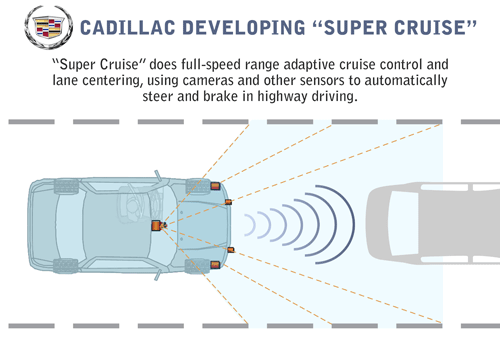Self-Driving Cadillacs Closer to Market


I’m barreling along at about 60 mph in a Cadillac SRX, and I’m Tweeting to the world while doing it — using both hands. The cruise control is set, and both of my passengers appear calm and relaxed while I do it. I’m keeping an eye on our situation, but I’m not doing any actual driving — I’m as much a passenger in this car as the guy sitting shotgun. That’s because this particular Caddy is currently driving itself, automatically following the curving road in front of me and responding to changes in the speed of the car in front of me.
This is what Cadillac calls “Super Cruise” mode — the next step on the path to fully autonomous vehicles, and it’s coming to a Cadillac near you before the decade is out.
Set the automatic distance-keeping cruise control to the speed you want, take your feet off the pedals, and the car takes over, keeping you at speed and responding to traffic in front of you. That part is familiar to anyone who has radar-based distance-keeping cruise control in their car; here’s where it gets weird – position the car in the lane aligned where you want to cruise and push the Super Cruise button on the steering wheel. An icon in the gauge cluster turns from white to green, and now the car is steering for you as well.
It’s all rather uneventful, really. Super Cruise operates at all speeds, and is designed to take some of the drudgery out of driving through uninteresting situations (such as boring Indiana interstates or Chicago’s commuter-congested highways). It’s designed to be able to steer up to the maximum curvature of most highways, using a camera to detect the painted lane lines on the road in front of you.
The system makes use of what automakers are starting to call “sensor fusion” — using all of the various detection systems like long-range radar, stereoscopic cameras and short-range ultrasonic sensors to get real-time information about what’s going on 360 degrees around the car. Combine that data with new computer-controlled systems like electric power steering, advanced braking control and other safety systems, and suddenly you have a car with the ability to steer, accelerate and brake itself. It not only can do these things, but it knows when to do these things — and when not to.
There are some restrictions on what the system can do. You still need to be present, alert and awake — no nodding off to take a nap while the car drives you to Florida. It will brake you quickly and suddenly if it detects a collision is imminent, even right down to a full stop — but it won’t steer you around an obstacle; that’s still your job. Super Cruise only works on highways, not urban areas, as GM believes that the relatively controlled conditions on the highway are easier and safer to predict than the constantly changing urban environment (there are no errant pedestrians on the highway, for instance). There must be clearly painted lines that the car’s camera can recognize in order for the system to keep you within them. But in the right conditions, Super Cruise has the potential to change the way a lot of people use their cars, especially over longer distances.
GM says that the system is not yet ready for prime time — “later this decade” is as specific as company representatives will get when asked when we should expect it in showrooms. The company is understandably paranoid about liability and making sure that the system can handle just about any situation the environment throws at it, something that can only be assured through massive amounts of testing and redundancy. With Nissan just announcing that it will have a fully autonomous vehicle by 2020, a claim the GM people quietly met with considerable skepticism, and Google already demonstrating its own autonomous car out on public roads, the race seems to be on to get such systems into consumers’ hands.
Related
Cadillac Takes Self-Driving Tech to the Streets
Nevada Passes Law Permitting Autonomous Cars
Research Cadillac Models on Cars.com

Detroit Bureau Chief Aaron Bragman has had over 25 years of experience in the auto industry as a journalist, analyst, purchasing agent and program manager. Bragman grew up around his father’s classic Triumph sports cars (which were all sold and gone when he turned 16, much to his frustration) and comes from a Detroit family where cars put food on tables as much as smiles on faces. Today, he’s a member of the Automotive Press Association and the Midwest Automotive Media Association. His pronouns are he/him, but his adjectives are fat/sassy.
Featured stories

15-Year Car Loans Aren’t a Thing, But Americans Are Getting More Comfortable With Long Loan Terms

2025 Kia Telluride Review: Rougher Roads Ahead



